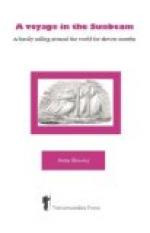Saturday, October 28th.—At 5 a.m. we were called, and soon afterwards parting gifts of flowers began to arrive, and even I was obliged to confess that four large clothes-baskets full of rosebuds were more than I quite knew what to do with. At seven Mr. Long came to know if he could help us in any way, and a little later Madame Cousino’s coachman appeared with the carriage, to take us to the station.
We had a pleasant drive down the Alameda, the sun shining brilliantly in a bright blue sky, and the distant mountains for the first time being clearly visible. The station was crowded with vendors of pottery, curious things in buffalo horn, sweetmeats, &c. The rolling stock on this line is of English manufacture, and we were therefore put into the too familiar, close, stuffy, first-class carriage, and duly locked up for the journey down to Valparaiso. The line, running as it does through mountain gorges for a great portion of the way, must have been a difficult one to make.
Just now the whole country wears a golden tint from the bloom of the espinosa, which seems to grow everywhere, and which is now in perfection. The branches of this shrub are so completely covered with little yellow balls of flowers, which come before the leaves, and which have no separate stalk, but grow along the shiny, horny branches, that they look as if they were made of gold. It is called the ‘burning bush’ here, and its wood is said to be the hardest in the country. The flowers are often plucked off and dried, in which state they are most fragrant and are used for scenting linen and for keeping away moths. The thorns, however, are a terrible nuisance to the shepherds and owners of cattle, catching their clothes and tearing them as they gallop swiftly across over the plains. If I bore you by saying too much about the flowers, forgive me. I want to make you all realise, if possible, what a lovely flowery land Chili is. The whole air is quite perfumed with roses, principally large double pink roses, something like the old-fashioned cabbage rose, though there are a good many of the monthly kind and a few white and deep scarlet ones. They formed hedgerows on either side of the road, and in many places climbed thirty or forty feet up the trees, and then threw down long brambles laden with bloom, almost producing the effect of a wall of pink. There were also plenty of wild flowers of other sorts, such as scarlet and white lilies, larkspurs, eschscholtzias, evening primroses, and many others whose names I do not know.
At Llaillai we stopped for breakfast, procured at a small restaurant at the station. While waiting for the train for Santiago to come in, we had plenty of time to observe the half-Indian girls selling fruit, flowers, cakes, &c., and jabbering away in a sort of patois Spanish, in recommendation of their wares. Some of them were really pretty, and all were picturesquely dressed in bright-coloured stuffs,




